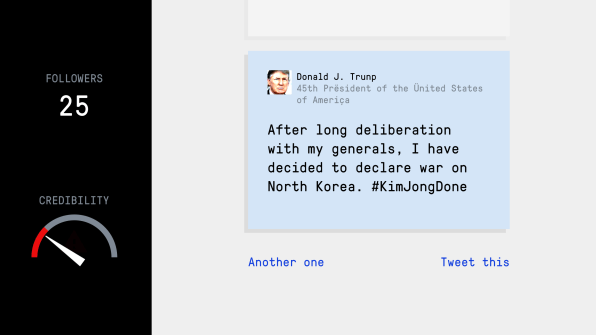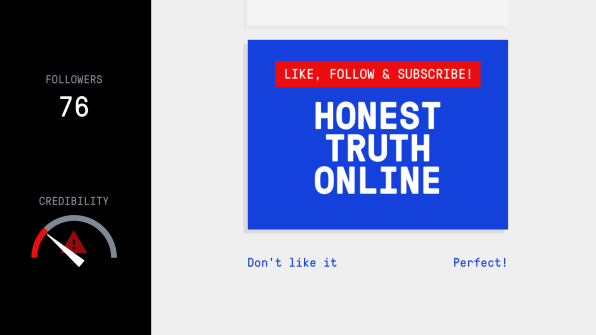To win a new game, you earn badges for trolling, impersonation, and spreading conspiracy theories through a fake news site, Twitter bots, and Photoshop. The goal of the game, called Bad News, is to spread fear, anger, and public mistrust. The bigger goal: to help players get better at recognizing fake news in real life.
Researchers at the University of Cambridge created the game, along with designers from the Dutch media collective Drog, after their previous research showed that exposing people to a small amount of misinformation could help inoculate them against more fake news.

“Just as vaccines involve injecting yourself with the small or weakened dose of a virus that triggers antibodies in the immune system to help confer resistance against future infection, the idea is that you could do the same with information just by exposing people to a weak or a small dose of misinformation,” says Sander van der Linden, director of Cambridge University’s Social Decision-Making Lab.
An earlier study, published in 2017, was focused on misinformation about climate change. But after widespread interest in how the same techniques could be for other subjects, the team started considering another approach. “It’s very costly to sort of tailor the vaccination in that way, and so we wondered, is there a way to sort of educate people on a broader level to confer this type of resistance?” says van der Linden. “What we came up with is the idea that if you walk a mile in the shoes of someone who’s trying to deceive you, you’re going to be much faster at spotting those tactics–and potentially more resistant to being influenced by them because you recognize them. You’ve rehearsed them, you’ve interacted with that.”
In the simple game, players practice impersonation; at one point, you might fake a tweet from Donald J. “Trunp” about declaring war on North Korea, with the hashtag #KimJongDone. (“Nicely done!” the game says. “War with North Korea is just realistic enough to worry people.”) You’ll start a fake news site–mine was called Honest Truth Online–and learn how to exploit anger and fear, while maintaining a basic “credibility score” so you don’t lose followers.

In a pilot test, the researchers studied a pen-and-paper version of the game with a small group of high school students. The students were given a fact sheet on asylum seekers, and then played the roles of alarmists, conspiracy theorists, or clickbait mongers, using the game’s techniques to distort the facts. By the end of the process, they were more likely to question fake news about refugees than their classmates who hadn’t gone through the process.
The online game asks players if they’re willing to take part in an experiment–answering a few surveys throughout the game–and the researchers will use that data to perform a larger study. “We’re hoping, after we’ve got hundreds of thousands of responses, to actually evaluate how effective the game is in conferring resistance,” says van der Linden. They’re also working on variations of the game, including one for children with different subject matter (fake news about Spongebob Squarepants). The current version will be translated into Russian, so it can be used in places like the Ukraine, where fake news is rampant.
The same framework could also be used to expose the techniques used by recruiters for extremist groups. “Radicalization is something I’m very interested in,” van der Linden says. “In conflict areas in Africa and Latin America, there’s a real opportunity for these sort of game interventions to help.”
Fast Company , Read Full Story
(41)